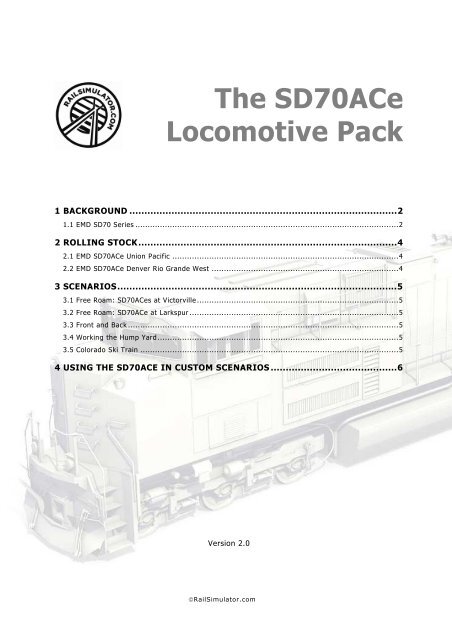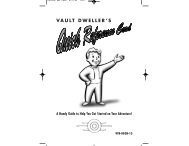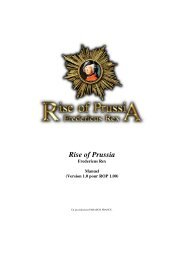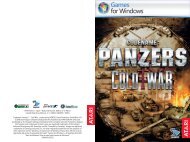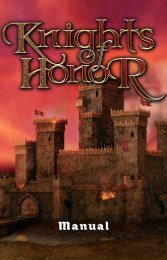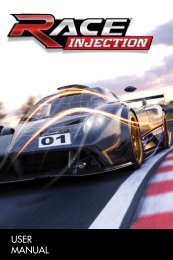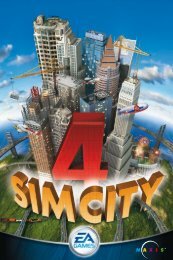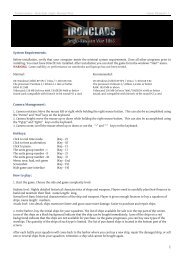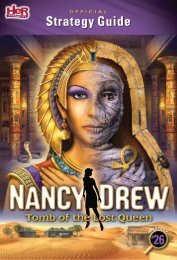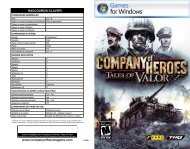SD70ACe Locomotive Pack - Steam
SD70ACe Locomotive Pack - Steam
SD70ACe Locomotive Pack - Steam
Create successful ePaper yourself
Turn your PDF publications into a flip-book with our unique Google optimized e-Paper software.
The <strong>SD70ACe</strong><br />
<strong>Locomotive</strong> <strong>Pack</strong><br />
1 BACKGROUND .........................................................................................2<br />
1.1 EMD SD70 Series ...........................................................................................................2<br />
2 ROLLING STOCK ......................................................................................4<br />
2.1 EMD <strong>SD70ACe</strong> Union Pacific ............................................................................................4<br />
2.2 EMD <strong>SD70ACe</strong> Denver Rio Grande West ............................................................................4<br />
3 SCENARIOS.............................................................................................5<br />
3.1 Free Roam: <strong>SD70ACe</strong>s at Victorville ..................................................................................5<br />
3.2 Free Roam: <strong>SD70ACe</strong> at Larkspur .....................................................................................5<br />
3.3 Front and Back ..............................................................................................................5<br />
3.4 Working the Hump Yard ..................................................................................................5<br />
3.5 Colorado Ski Train .........................................................................................................5<br />
4 USING THE SD70ACE IN CUSTOM SCENARIOS ..........................................6<br />
Version 2.0<br />
©RailSimulator.com
1 Background<br />
1.1 EMD SD70 Series<br />
RailWorks – <strong>SD70ACe</strong> <strong>Locomotive</strong> <strong>Pack</strong><br />
The EMD SD70 is a series of diesel-electric locomotives produced by the Electro-Motive<br />
Division of General Motors beginning in 1992. Over 4000 locomotives in this series have been<br />
produced, mostly of the SD70M and SD70MAC models. All locomotives of this series are hood<br />
units with C-C trucks.<br />
SD70<br />
The SD70 uses the smaller standard cab or spartan cab, common on older locomotives,<br />
instead of the larger new comfort cab. This model also has DC traction motors, which<br />
simplifies the electrical system by cutting out the need for computer-controlled inverters.<br />
120 examples of this locomotive were produced, for Norfolk Southern Railway, Conrail,<br />
Illinois Central and Southern Peru Copper.<br />
Production of the standard cab ended in 1994. The 24 Conrail SD70s were assembled from<br />
kits at Juniata, and the IC and SPC SD70s were assembled from kits at Super Steel<br />
Schenectady. Nearly all SD70s are still in service with Norfolk Southern Railway and<br />
Canadian National, which merged with the Illinois Central in 1999.<br />
SD70M<br />
The SD70M has a wide nose and a large comfort cab or 'Safety Cab' in North America,<br />
allowing crew members to ride more comfortably inside of the locomotive than the older<br />
standard cab designs. There are two versions of this cab on SD70Ms, the Phase I, which was<br />
introduced on the SD60M, and is home on the SD80MAC and SD90MACs and the Phase II,<br />
which made a return to a more boxy design of the SD60M. Though the Phase II cab has a<br />
two piece window matching the Phase I cab, the nose features a taller square midsection for<br />
more headroom. The <strong>SD70ACe</strong>/SD70M-2 line has what is considered a Phase III cab. This<br />
encompasses windows that are rectangular. Like the SD70, the SD70M also uses DC traction<br />
motors.<br />
Starting in mid-2000, the SD70M was produced with SD45-style flared radiators allowing for<br />
the larger radiator cores needed for split-cooling. There are two versions of this radiator, the<br />
older version with two large radiator panels per side, and the newer style with four square<br />
panels per side. This was due to the enactment of the EPA's Tier I environmental<br />
regulations. Production of the SD70M was replaced by the SD70M-2 in late 2004, as the<br />
EPA's Tier II regulations went into effect on January 1, 2005.<br />
1,646 examples of this locomotive were produced. SD70M locomotives were produced with<br />
4000 horsepower (2,980 kW) EMD 710 engines. Purchasers included CSX, New York<br />
Susquehanna & Western, Norfolk Southern and Southern Pacific, but the vast majority were<br />
purchased by Union Pacific.<br />
SD70I<br />
The SD70I is a version of the SD70M which has been fitted with a cab that is isolated from<br />
the frame of the locomotive by rubber gaskets. The isolation reduces noise and vibration<br />
from the prime mover. A seam is visible across the nose and on the long hood where the cab<br />
connects with the body.<br />
26 of this locomotive were produced, all for Canadian National.<br />
© Copyright RailSimulator.com 2010, all rights reserved Release Version 2.0
RailWorks – <strong>SD70ACe</strong> <strong>Locomotive</strong> <strong>Pack</strong><br />
SD70MAC<br />
The SD70MAC is very similar to the SD70M and SD70I, the main difference being that the<br />
SD70MAC uses AC traction motors. AC motors, while simpler and more reliable than DC<br />
motors, require expensive inverters to generate a variable-frequency AC signal, raising the<br />
locomotive's purchase cost substantially. The majority of SD70MAC models were produced<br />
with 4000 horsepower (2,980 kW) EMD 710 engines, while later-production<br />
SD70MACs are rated at 4300 horsepower (3,210 kW) and feature SD45-style flared radiators.<br />
They were also offered with a head-end power generation system for passenger trains.<br />
Over 1500 of this locomotive were produced. Purchasers include Burlington Northern (now<br />
BNSF Railway), Conrail (engines now owned by CSX Transportation), CSX, TFM/Kansas City<br />
Southern Railway and the Alaska Railroad.<br />
<strong>SD70ACe</strong><br />
The <strong>SD70ACe</strong> is similar to the SD70MAC; however, it has been updated to meet the latest<br />
EPA regulations for locomotives. Several other changes were included. The radiator on the<br />
locomotive is nearly as wide as the cab, and looks similar to the radiator on the SD80 and<br />
SD90 series of locomotives. The nose has been modified, producing a much more angular<br />
design than previous. The cables and brake lines have been routed beneath the walkways,<br />
allowing for easy access by maintenance workers. The <strong>SD70ACe</strong> is rated at 4,300 horsepower<br />
(3,200 kW).<br />
As of 2005, 191 of this locomotive have been produced. Purchasers include BNSF Railway,<br />
CSX Transportation, Ferromex, Kansas City Southern Railway, Montana RailLink, CVG<br />
Ferrominera Orinoco , Union Pacific Railroad and Quebec North Shore and Labrador Railway,<br />
BHP Billiton.<br />
<strong>SD70ACe</strong>/lc<br />
In 2004, BHP Billiton of Australia ordered 14 <strong>SD70ACe</strong>/lc locomotives for use in iron ore<br />
hauling; the "lc" designation stands for "low clearance" as these locomotives are designed to<br />
negotiate the tight clearances under the mine equipment. Certain external differences<br />
between the <strong>SD70ACe</strong> and <strong>SD70ACe</strong>/lc models include the addition of marker lights, number<br />
boxes lower in the body rather on top of the cab, windscreen protector panels, fire<br />
suppression canisters, louvre style vents, different horn and subtle differences with<br />
handrails.<br />
Of the first batch of <strong>SD70ACe</strong>/lc (Numbers 4300-4313), 4301-4313 are named after sidings<br />
on the BHP system. 4300 is used for spare parts and has never seen service. The second<br />
batch of locomotives (Numbers 4313-4323), have a newly designed isolated cab. An order for<br />
a third batch of 13 <strong>SD70ACe</strong>/lcs (Numbers 4334-4346) was placed with EMD in August 2007.<br />
But such was the demand for locomotive power in the Pilbara region, ten <strong>SD70ACe</strong> destined<br />
for BNSF were purchased before this third batch was constructed, becoming numbers 4324-<br />
4333. These ten ex-BNSF locos (ex-9166, 9167, 9184-9191) are in the BNSF Orange with<br />
white BHP Billiton lettering and are standard North American <strong>SD70ACe</strong> units. Some<br />
modifications have been made to bring them inline with the rest of the fleet. A fifth batch of<br />
<strong>SD70ACe</strong>/lc (Numbers 4347-4355) was recently delivered to BHP Billiton in July 2009,<br />
bringing the total of <strong>SD70ACe</strong> type locomotives to 55 + 1 for spare parts. An Additional 18<br />
units are expected to be delivered in the 2nd half of 2010.<br />
© Copyright RailSimulator.com 2010, all rights reserved Release Version 2.0
2 Rolling Stock<br />
The following two liveries are provided in the <strong>SD70ACe</strong> pack:<br />
2.1 EMD <strong>SD70ACe</strong> Union Pacific<br />
RailWorks – <strong>SD70ACe</strong> <strong>Locomotive</strong> <strong>Pack</strong><br />
This locomotive appears as “EMD <strong>SD70ACe</strong> UP” in the editor browser list.<br />
2.2 EMD <strong>SD70ACe</strong> Denver Rio Grande West<br />
This locomotive appears as “EMD <strong>SD70ACe</strong> DRGW” in the editor browser list.<br />
© Copyright RailSimulator.com 2010, all rights reserved Release Version 2.0
3 Scenarios<br />
3.1 Free Roam: <strong>SD70ACe</strong>s at Victorville<br />
• Start Location Victorville Yard<br />
• Career Mode No<br />
3.2 Free Roam: <strong>SD70ACe</strong> at Larkspur<br />
• Start Location Larkspur Yard<br />
• Career Mode No<br />
3.3 Front and Back<br />
• Rating Easy<br />
• Duration 40mins<br />
• Career Mode Yes<br />
RailWorks – <strong>SD70ACe</strong> <strong>Locomotive</strong> <strong>Pack</strong><br />
Drive an <strong>SD70ACe</strong>-led freight train to Oro Grande. On the way you need to drop off<br />
the rear half of your train at Victorville. There is no timetable but you are to follow in<br />
the signal block of a refrigerator boxcar train. Also, your score is initially set at 1000<br />
powers. Your aim is to maintain that score.<br />
3.4 Working the Hump Yard<br />
• Rating Very hard<br />
• Duration 60mins<br />
• Career Mode Yes<br />
Driving an <strong>SD70ACe</strong> you need to bring freight cars from Barstow Hump Yard to make<br />
two separate rakes at Barstow East Yard. Starting with a score of 1000 you will have<br />
points deducted for poor switching and overspeeding, so take your time and be safe.<br />
3.5 Colorado Ski Train<br />
• Rating Medium<br />
• Duration 35mins<br />
• Career Mode Yes<br />
Drive UP Heritage <strong>SD70ACe</strong> 1989 on a passenger special taking skiers down the<br />
length of the route. Aim to reach Monument by 14:35.<br />
© Copyright RailSimulator.com 2010, all rights reserved Release Version 2.0
RailWorks – <strong>SD70ACe</strong> <strong>Locomotive</strong> <strong>Pack</strong><br />
4 Using the <strong>SD70ACe</strong> in Custom Scenarios<br />
Before you are able to use the <strong>SD70ACe</strong> locomotives in your own scenarios you must<br />
enable it in the object set filters for that scenario.<br />
When you make your own scenarios, or edit existing ones,<br />
only the default object sets are enabled for that route (for<br />
example the Kuju/Railsimulator assets for European routes<br />
and Kuju/RailsimulatorUS for North American routes). To<br />
enable additional object sets (which could be for any<br />
downloaded or freeware content) ready for use they must<br />
be checked in the object set filter list in the editors.<br />
When editing the scenario you wish to add the <strong>SD70ACe</strong><br />
locomotives to, ensure you are in the Scenario Editor and<br />
click the small blue square on the middle left panel.<br />
This opens a new panel on the right hand side of the<br />
screen (you may need to move your mose over to the right<br />
hand side for the panel to fly out. You can pin it open if<br />
you wish).<br />
This new panel has a drop down list off providers<br />
(usually the company name which produced the add-on)<br />
and a list off all products by that provider.<br />
The <strong>SD70ACe</strong> pack is produced by Railsimulator.com so<br />
RSC needs to be selected as the provider. The rest of<br />
the panel is then populated by all other RSC products<br />
you have purchased.<br />
To enable the content of the pack for use in this<br />
scenario, check the box next to “Dash9<strong>Pack</strong>01”.<br />
Now the <strong>SD70ACe</strong> engines will be available in the asset<br />
browser list for placement in the current scenario only.<br />
If you want the <strong>SD70ACe</strong> engines to appear in the<br />
browser list for EVERY scenario on a route you must<br />
follow the same procedure but be in the World Editor<br />
and you can now check the first box.<br />
The slight disadvantage of having content enabled for all<br />
scenarios on a route, even when that content may not be<br />
used, is increased loading times.<br />
© Copyright RailSimulator.com 2010, all rights reserved Release Version 2.0


